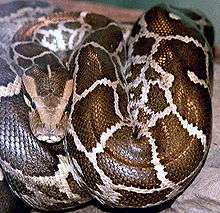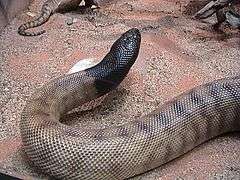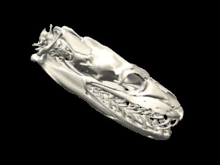Pythonidae
| Pythonidae | |
|---|---|
 | |
| Indian python (Python molurus) | |
| Scientific classification | |
| Kingdom: | Animalia |
| Phylum: | Chordata |
| Class: | Reptilia |
| Order: | Squamata |
| Suborder: | Serpentes |
| Superfamily: | Pythonoidea |
| Family: | Pythonidae Fitzinger, 1826 |
| Synonyms | |
| |
The Pythonidae, commonly known simply as pythons, from the Greek word python (πυθων), are a family of nonvenomous snakes found in Africa, Asia, and Australia. Among its members are some of the largest snakes in the world. Eight genera and 31 species are currently recognized.[2]
Distribution and habitat
Pythons are found in sub-Saharan Africa, Nepal, India, Sri Lanka, Burma, southern China, Southeast Asia, and from the Philippines southeast through Indonesia to New Guinea and Australia.[1]
In the United States, an introduced population of Burmese pythons, Python molurus bivittatus, has existed as an invasive species in the Everglades National Park since the late 1990s.[3]
Conservation
Many species have been hunted aggressively, which has greatly reduced the population of some, such as the Indian python, Python molurus.
Behavior

Aspidites melanocephalus
Most members of this family are ambush predators, in that they typically remain motionless in a camouflaged position, and then strike suddenly at passing prey. They will generally attack any animal or humans when feeling hungry or provoked.[4] Pythons longer than 2.1 m can kill adult humans[5] even if the weight of snake is just 20 kg.[6] Reports of attacks on humans were once common in South and Southeast Asia but are now quite rare, although females protecting their eggs can be aggressive. In March 2017 a 25 year old man was found dead inside a 23 foot python on the island of Sulawesi, Indonesia[7] and in June 2018 a 54 year old woman was found dead in a similar sized python.[8]
Feeding
Pythons use their sharp, backward-curving teeth, four rows in the upper jaw, two in the lower, to grasp prey which is then killed by constriction; after an animal has been grasped to restrain it, the python quickly wraps a number of coils around it. Death occurs primarily by cardiac arrest.[9][10]
Larger specimens usually eat animals about the size of a house cat, but larger food items are known; some large Asian species have been known to take down adult deer, and the African rock python, Python sebae, has been known to eat antelope. In 2017, there was a recorded case of a human devoured by a python in Sulawesi, Indonesia.[11] All prey is swallowed whole, and may take several days or even weeks to fully digest.
Contrary to popular belief, even the larger species, such as the reticulated python, P. reticulatus, do not crush their prey to death; in fact, prey is not even noticeably deformed before it is swallowed. The speed with which the coils are applied is impressive and the force they exert may be significant, but death is caused by cardiac arrest.

Reproduction
Pythons are oviparous, that is, they lay eggs. This sets them apart from the family Boidae (boas), most of which bear live young (ovoviviparous). After they lay their eggs, females typically incubate them until they hatch. This is achieved by causing the muscles to "shiver", which raises the temperature of the body to a certain degree, and thus that of the eggs. Keeping the eggs at a constant temperature is essential for healthy embryo development. During the incubation period, females will not eat and only leave to bask to raise their body temperature.
Captivity
Most species in this family are available in the exotic pet trade. However, caution must be exercised with the larger species, as they can be dangerous; rare cases of large specimens killing their owners have been documented.[12][13]
Genera
| Genus[2] | Taxon author[2] | Species[2] | Subsp.*[2] | Common name | Geographic range[1] |
|---|---|---|---|---|---|
| Antaresia | Wells & Wellington, 1984 | 4 | 0 | Children's Pythons | Australia in arid and tropical regions |
| Apodora | Kluge, 1993 | 1 | 0 | Papuan Python | Most of New Guinea, from Misool to Fergusson Island |
| Aspidites | Peters, 1877 | 2 | 0 | Shield Pythons | Australia except in the south of the country |
| Bothrochilus | Fitzinger, 1843 | 1 | 0 | White-Lipped Pythons | Most of New Guinea (below 1200 m), including the islands of Salawati and Biak, Normanby, Mussau, as well as a few islands in the Torres Strait |
| Liasis | Gray, 1842 | 3 | 2 | Water Pythons | Indonesia in the Lesser Sunda Islands, east through New Guinea and in northern and western Australia |
| Morelia | Gray, 1842 | 7 | 5 | Tree Pythons | From Indonesia in the Maluku Islands, east through New Guinea, including the Bismarck Archipelago and in Australia |
| PythonT | Daudin, 1803 | 7 | 4 | "True" Pythons | Africa in the tropics south of the Sahara (not including southern and extreme southwestern Madagascar), Bangladesh, Pakistan, India, Sri Lanka, the Nicobar Islands, Burma, Indochina, southern China, Hong Kong, Hainan, the Malayan region of Indonesia and the Philippines |
*) Not including the nominate subspecies.
T) Type genus.[1]
Taxonomy
Obsolete classification schemes—such as that of Boulenger (1890)—place pythons in Pythoninae, a subfamily of the boa family, Boidae.[1] However, despite a superficial resemblance to boas, pythons are more closely related to sunbeam snakes (Xenopeltis) and burrowing pythons (Loxocemus).[14][15]
References
- 1 2 3 4 5 McDiarmid RW, Campbell JA, Touré T. 1999. Snake Species of the World: A Taxonomic and Geographic Reference, vol. 1. Herpetologists' League. 511 pp. ISBN 1-893777-00-6 (series). ISBN 1-893777-01-4 (volume).
- 1 2 3 4 5 "Pythonidae". Integrated Taxonomic Information System. Retrieved 13 April 2016.
- ↑ "Huge, Freed Pet Pythons Invade Florida Everglades", National Geographic News. Accessed 16 September 2007.
- ↑
- ↑ "Why an 8-Foot Pet Python May Have Killed Its Owner". 2018-01-26. Retrieved 2018-05-13.
- ↑ "Python kills careless student zookeeper in Caracas". 2008-08-26. ISSN 0307-1235. Retrieved 2018-05-13.
- ↑ Wang, Amy B. (29 March 2017). "An Indonesian man disappeared. Villagers found his body inside a 23-foot-long python". Washington Post. Retrieved 17 June 2018.
- ↑ Selk, Avi (16 June 2018). "A woman went to check her corn — and was swallowed by a python". Washington Post. Retrieved 17 June 2018.
- ↑ Hardy, David L (1994). "A re-evaluation of suffocation as the cause of death during constriction by snakes". Herpetological Review. 229: 45–47.
- ↑ Boback, Scott M.; McCann, Katelyn J.; Wood, Kevin A.; McNeal, Patrick M.; Blankenship, Emmett L.; Zwemer, Charles F. (1 July 2015). "Snake constriction rapidly induces circulatory arrest in rats". Journal of Experimental Biology. 218 (14): 2279–2288. doi:10.1242/jeb.121384. PMID 26202779 – via jeb.biologists.org.
- ↑ France-Presse, Agence (29 March 2017). "Giant python swallows Indonesian farmer whole" – via www.theguardian.com.
- ↑ "The Keeping of Large Pythons" at Anapsid. Accessed 16 September 2007.
- ↑
- ↑ Pyron, R. A.; Burbrink, F.; Wiens, J. J. (2013). "A phylogeny and revised classification of Squamata, including 4161 species of lizards and snakes". BMC Evolutionary Biology. 13: 93.
- ↑ Reynolds, R. G.; Niemiller, M. L.; Revell, L. J. (2014). "Toward a Tree-of-Life for the boas and pythons: multilocus species-level phylogeny with unprecedented taxon sampling" (PDF). Molecular Phylogenetics and Evolution. 71: 201–213. doi:10.1016/j.ympev.2013.11.011.
External links
| Wikispecies has information related to Pythonidae |
| Wikimedia Commons has media related to Pythonidae. |
- Pythonidae at the Reptarium.cz Reptile Database. Accessed 3 November 2008.
- Pythons (Pythonidae) at Answers.com. Accessed 3 November 2008.